September 28–October 09, 2014
This is a true photographic expedition to experience some of the most beautiful tribes in remote areas on the African continent.
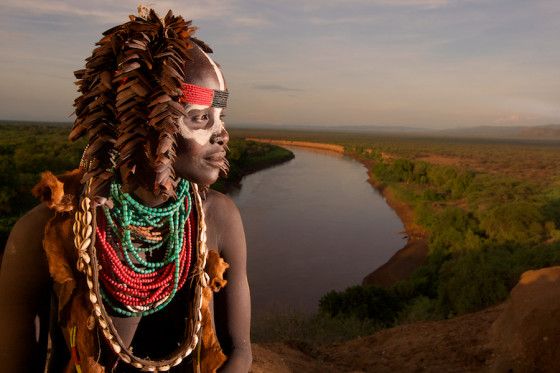
Kara woman along the Omo River
In September, I will lead a small group of only 7 photographers into southern Ethiopia’s Omo Valley, one of the most culturally rich tribal regions on the African continent. Inspired by their environment of wild trees, exotic flowers and lush vegetation these tribes use colorful make-up, of bright yellows, startling whites and rich earth-reds created from the clay soil, to become a walking body of art. As a celebration of themselves they paint each other’s bodies and make bold decisions about their outfits motivated by the sheer fun of creating and showing off to other members of the tribe.
For generations these tribes have been shielded from the modern world in a place that is still raw, natural, and timeless. However, change is happening quickly in this region, which is impacting their traditional clothing, body painting and way of life. This is not a trip to put off.
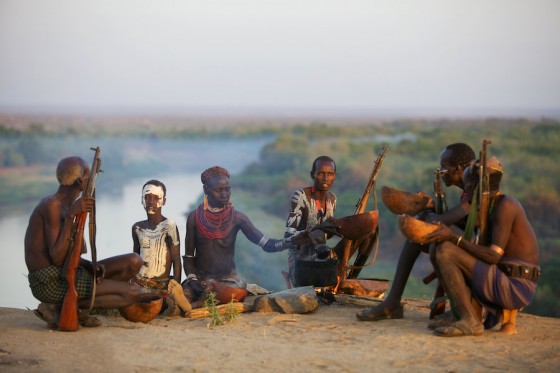
Kara tribe having morning coffee
We have access to the villages of the Arbore, Kara, Hamar, Dassenech. This is an opportunity to photographically document their daily lives, as well as experience some of their timeless ceremonies. It is likely we will meet several other tribes along the way and in route, so the precise time spent in each village will depend on what activities are taking place and the goals of the group. In true expedition style I have left the program flexible to ensure there is enough time to immerse our selves in these cultures and take advantage of any photographic opportunities that may arise. This will truly be an experience of a lifetime!
HIGHLIGHTS
- Visit one of the world’s most remote tribal areas that few have photographed
- Comfortable 4X4 vehicles with air-conditioning.
- Very experienced local guide, whom I have work with previously and who are experienced working with professional photographers and in negotiating with the tribes.
- A small group limited to 7 participants, most tours are 10+ making it more difficult to photograph in a village setting
- Photograph a way of life that will soon be lost to the world and that most people will only experience through the pages of a magazine
THE ITINERARY
Day 1 – September 28, 2014 Arrive Addis (1 night)
Arrive at Bole International Airport, Addis Ababa, Ethiopia. You are met and transferred to our hotel by private vehicle. Meet the tour leader for orientation this evening. Overnight at the Blu.
Day 2 – September 29, 2014 Arba Minch (1 night)
We rise very early this morning for Ethiopia’s famous Coffee and a quick breakfast. We depart for Abra Minch, which is situated in the Great Rift Valley. The drive will give us time to decompress from modern life and sink into the ambience, the beauty, and the rhythm of Africa.
We pass by tall thatch roof huts fantastically painted in African style art with an ornate piece of pottery crowning its top. The local people are going about their daily lives in the village, working the fields, carrying large Jerry cans of water, and creating pottery and handicrafts that will be sold in the local market. Private vehicles are sparse on these roads, which are used more for driving herds of livestock, public transport, and walking from the villages to town. We arrive in the early evening as the sun begins to descend and the road changes to dirt stirring up the rich red African soil creating a golden orange glow over the landscape.
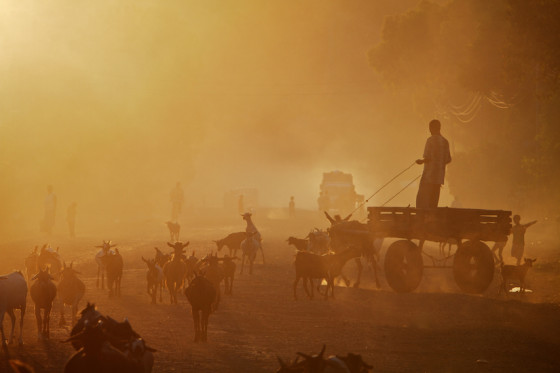
Day 3, – September 30, 2014 Turmi (3 nights- Buska Lodge)
This morning we head to the Omo Valley arriving in Turmi, home of the Hamar tribe. The Hamar women are striking; wearing beautiful colorful beaded skins, ornate necklaces, and metal bangles around their wrist and ankles. Famous for their hairstyle — a crown of long dread-lock braids covered in ocher — the Hamer women are the most decorated of the Omo people. We will arrive in time for a late lunch, get settled in and then have an afternoon visit at a Hamar village. We will over night at Buska Lodge. This will be our home base for the next three nights, which will increase our chances to be invited to a bull jumping ceremony or something special and allows us to capitalize on all the photographic opportunities in the area. It allows us to be flexible and gives us access to the Arbore and Dassenech tribes.
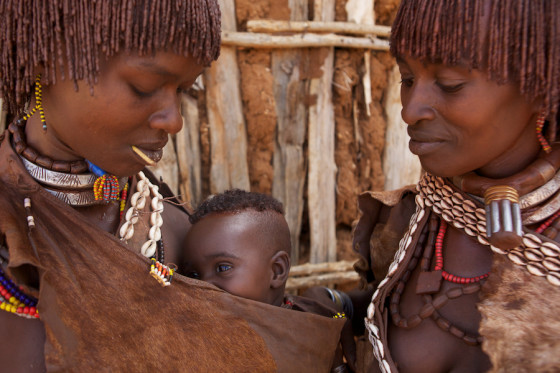
Two Hamar women with a child
Day 4 – October 1, 2014
Today we will rise early and drive to the Arbore tribe. Each tribe of the Omo valley has a specific way of dressing and decorating themselves as a way to visually associate themselves with their unique customs and values. Arbore women are well known for their long headdresses. The girls shave their heads to indicate virginity, and only start growing hair after marriage.
Afternoon – we will hope for word of a bull jumping rehearsal or ceremony- if not we will visit with the Hamar tribe.
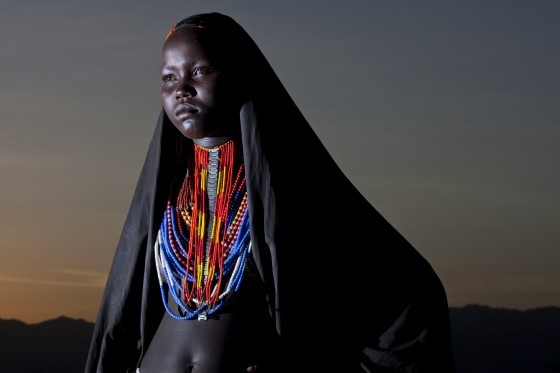
Abore Tribe
Day 5 – October 2, 2014 Turmi
This morning we will rise early and drive to the edge of the Omo River. We will cross the river by canoe to the villages of the Daasanech tribes (a motor boat or a ferry maybe available but is not guaranteed). The Daasanech are a semi-nomadic tribe numbering approximately 50,000. Their clans stretch across Sudan, Kenya and Southern Ethiopia. The are known for their very unique and ornate hair buns.
Afternoon – we will hope for word of a bull jumping rehearsal or ceremony- if not we will visit a Hamar village and try to arrange something special.
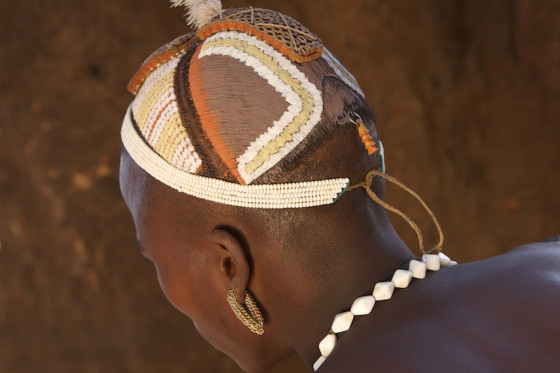
Hairbun, Daasanach Tribe
Day 6 – October 3, 2014 Turmi Murulle (3 nights- Murulle Lodge)
This morning we will have our last visit with the Hamar at sunrise and shoot in the soft morning light. We will head back to the lodge for a late breakfast and to check out. We then head to Kara territory where we will settle into our lodge on the banks of the Omo River.
The Kara excel in face and body painting that is practiced daily in preparation of their dances and ceremonies. They pulverize locally found white chalk, yellow mineral rock, red iron ore and black charcoal to decorate their bodies often mimicking the spotted plumage of a guinea fowl. The men create highly decorated clay hair buns, which can take up to three days to complete. Their ornate body scaring where a cut is made with a knife and ash is rubbed into the wound to produce a raised welt is also a known characteristic of the Kara. This afternoon will be our first visit with the Kara
Day 7 -8 October 4-5, 2014
I find the Kara to be one of the friendliest tribes along the Omo. I have sent a lot of time with this tribe building lifetime friendships and love spending time with them.
We have two full days to photograph this amazing tribe. We will be able to photograph them in their villages, along the river, set up individual and group portraits, see how the men make their elaborate hair-buns, experience tribal dancing, visit the main village in Dus, and just immerse ourselves into their culture. I find the Kara to be one of the friendliest tribes along the Omo. I have sent a lot of time with this tribe building lifetime friendships. Visiting the Kara is one of the highlights of the trip.
We may also be able to plan a visit the Nyangatom tribe across the river.
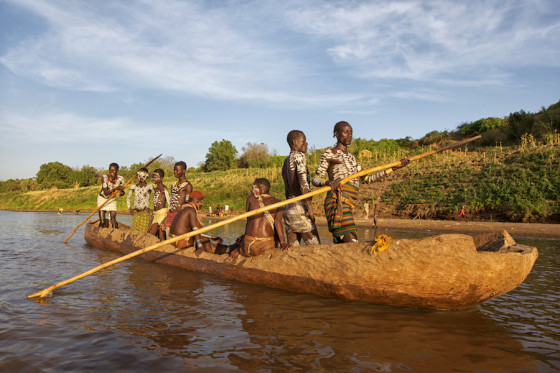
Kara tribe canoeing down the Omo River
Day 9 – October 6, 2014 (2 nights- Eco Lodge)
This morning we will have one last sunrise photo shoot with this tribe before heading to Jinka. If time allows we will have an afternoon visit to the Benna or Ari tribe.
Day 10 – October 7, 2014
Today we visit the Mursi Tribe. known for their lip plates, face painting, and fancy leather head pieces. The women first started using the lip plates as a way to disfigure themselves so the slave traders would be appalled by the way they look and not take them into slavery… later it became a sign of beauty used to get a husband.
In the afternoon we will visit the Omo child home. Omo child is an amazing foundation started by Lale Labuku from the Kara tribe, and photographer John Rowe. This organization is making a big difference in saving lives and educating the children. You will learn about all the wonderful changes that have taken place and give you a more complete picture of the Omo Valley. Here is a link to Omo Child if you are interested in learning more. http://omochild.org
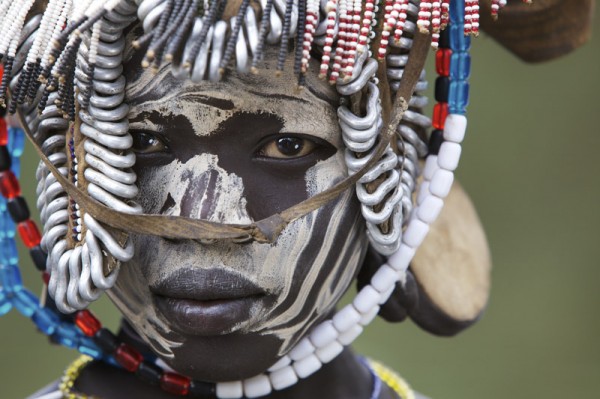
Mursi Tribe
Day 11 – October 8, 2014 (1 night)
This morning we will depart for Arba Minch. In route we will stop for a visit at a konso village; a world heritage site. The stone walled terraces are spectacular and you feel like you have gone back in time to a different century. We will have lunch at beautiful Kanta lodge before proceeding to Arba Minch. We will make one last stop at a borza village before arriving at our beautiful lodge in time to relax on the deck overlooking two lakes and share our stories of the Omo.
Day 12 – October 9, 2014 (1night)
We drive back to Addis where we will have day rooms until our transfer to the airport for our departure for home
Is this trip for you?
This expedition is for anyone who wants to experience some of the most remote and beautiful tribes on the African continent. This expedition is focused on producing high quality images of extraordinary subjects so we will be rising very early in the morning for the best light; a few mornings we rise well before sunrise. These tribes are remote; there will be some long drives and there will be driving on dirt roads, but in comfortable 4X4 utility vehicles. When the tarmac roads begin to take you directly to these tribes, the mass tourism will have begun to change their appearance and traditions forever.
This expedition was created for experienced photographers with a good working knowledge of the basics of photography, composition, and equipment. Depending on your vision, some experience working with flash is a bonus. Having experience working with indigenous cultures is recommend as this can be a more challenging experience photographically, but will provide you with some of the most extraordinary photographic opportunities of a lifetime. Although this is NOT a workshop there will be a lot of informal instruction and I am always available for any question you may have.
The tribes live in a remote location. There is no five star lodging in the Omo Valley, but we will be at the best accommodation available. In some locations the electricity is not on 24 hrs a day, but it will be on for several hours every morning and even, giving us plenty of time to charge up all our batteries and electronic equipment.
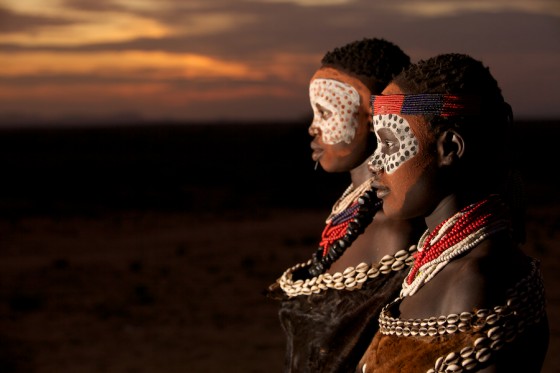
Kara Tribe
The Price
The price of this unique photographic expedition is $6,450.00 This price is based on double occupancy.
Single supplement is $900.00 ” if available”. Single accommodations are limited.
Due to the limited number of spaces available, if a solo guest is willing to share and we can match with another guest of the same gender, we will do so. If a solo guest is unwilling to share, then a single supplement will be charged. If we are unable to match a solo guest with another guest of the same gender, then the single supplement will be charged
What’s Included
- Accommodations
- All the 3 meals of the day with mineral water(except on arrival and departure days)
- Tourist standard 4X4 utility vehicle with air-conditioning
- Entry scout fees, villages fees, and road fees
- National English speaking escort guide and local tribal guides
- Gratuities for local guides
- Water, beer, soda, coffee (wine is not included as it is usually served by the bottle only, premium alcoholic drinks are not included)
- Gratuities for Camp and Lodge staff (outside of Addis)
- Photography fee’s
What’s NOT Included
- International airfare and/or between your home and Addis Abba
- Visas
- Travel Insurance (REQUIRED to participate on this trip)
- Personal purchases (including shopping, spirits, laundry, telephone calls, etc )
- Gratuities for our main guide and drivers
- Optional extra activities not included on the itinerary
- Extra photo fees
- Pre- and Post- expeditions tours
- Meals or accommodations before or after the expedition (except as noted in the detailed itinerary)
- Meals and beverages on the day of arrival, this is considered a travel day
Please Understand
Traveling in remote locations can present challenges that may require slight changes to the itinerary. I put my heart into each and every itinerary and will always try to run the tour as written in the initial itinerary. In the event of situations beyond my control, such as political unrest, natural disasters, overbookings by the lodge, where a change is required, I will do my best to keep us close to the original shooting location. It is my intention for you to have the best possible experience. I will try to notify you of any changes as soon as I am made aware of them. If, however these changes cause an increase to the price, the increase will be passed onto the participant.
Interested in Joining us?
The group size for this extraordinary photo tour is limited to just 7 participants. Due to the size of this group and the popularity of the location, this trip usually fills quickly. To secure your spot, please complete the On-line registration form and make the $1,200 non-refundable deposit. Both a completed reservation form and deposit must be done to confirm a spot. Once the tour is full, I will accept request for the wait list by email.
This trip is SOLD OUT –
click here, to place your name on the wait-list or to be placed on the first contact list for next years tour.
